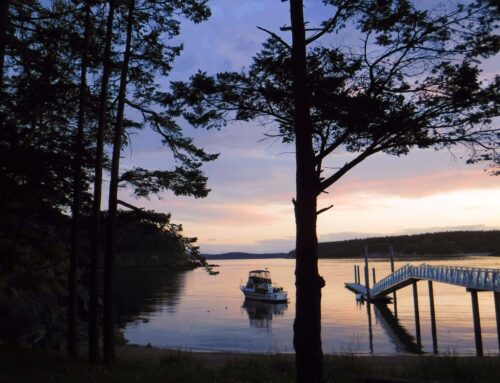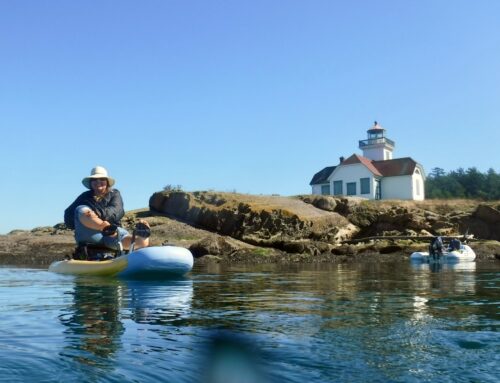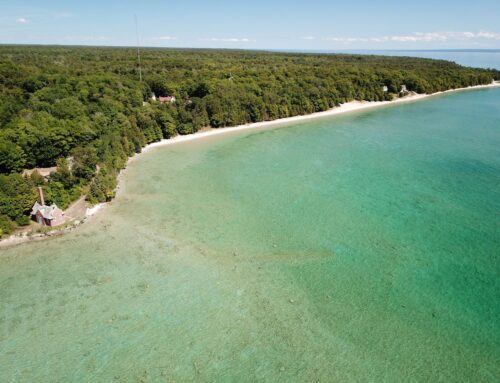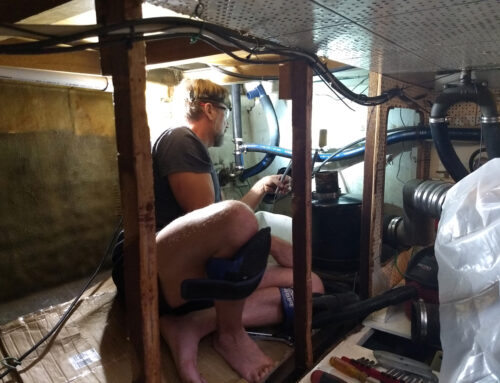This is a play-by-play account of our short overnight passage from Tenacatita to Banderas Bay. It seems like blogs are always about destinations so I thought I would share real-time how we spend 30 hours at sea. This passage was a bit tricky as it involved the rounding of a cape – Cabo Corrientes at the south end of Banderas Bay. All weather forecasts suggested benign conditions and favorable winds. Here is what really happened.
SATURDAY
0400 We’re at anchor in Tenacatita and I can’t sleep. I grab a headlamp and start reading my book. Mike wakes up 10 minutes later and is wide awake as well. We had planned on weighing anchor around sunrise (0730) but since we’re both up we decide to get going now. We run lifelines, get out our harnesses and tethers, and make sure everything is secured and ready to go.
While underway we are always tethered to the boat. We use harnesses because they are more comfortable than life jackets and we feel it is safer to be attached to the boat if someone goes over than to float away in a life jacket – especially when only one of us is on deck. When the weather gets nasty we wear life jackets with an integrated harness.
0530 The anchor has been weighed and we’re making our way out of the anchorage. Luckily there is a bright quarter moon because some boats didn’t turn on their anchor lights and others simply use little solar powered garden lights or a string of christmas lights. The boats who do have proper anchor lights are easy to spot because their lights cast a long beam of light across the water. If you have ever considered using anything other than a regulation anchor light please try leaving a crowded anchorage in the dark first.
0630 I go back to bed to a windless morning and the droning of the engine.
1030 I wake up with a slight case of mal de mer after our week at anchor. I put on my harness and relieve Mike who is ready to get some more sleep. I have a light breakfast of a hardboiled egg, avocado and water. We’re heading north, nearly straight into waves which are on top of a long swell. They are steep and short and Camille is pitching and heaving uncomfortably. I feel better now that I’ve gotten some fresh air and can see the waves coming. It’s a clear blue sky and just over 80 degrees Fahrenheit. Wish I could go for a swim…
1045 I settle into my favorite chair on the landing above the companion way. Out of the sun and wind and with a 360 degree view it’s a great place to sit out a watch. The autopilot is steering the boat and all I have to do is confirm we are still on course using the same iPad I’m using to take these notes, as well as keep our boat log. Every few minutes I confirm we won’t be colliding with anything and every couple of hours check the bilge and engine.
1320 In a steep wave right in front of the boat I suddenly see something floating just below the surface. It’s a small group of manta rays gliding along peacefully until they notice the boat coming at them and dive off in a panic at the last second.1130 I spot what appears to be a panga (small open fishing boats the locals use). As we get closer I start to notice a long string of evenly spaced soda-bottle-floats right in our path. I slow down to figure out where I could pass when the panga speeds over. The fishermen pick up one of the soda bottles to retrieve their lure and then motion for me to pass through the opening they have created in their mile-long “fence”. I thank them and continue on my way.
1340 Mike gets up and starts cooking lunch. Half way through cooking we run out of propane and have to switch to our other tank.
1500 Lunch/early dinner time. While we eat our cabbage and potatoes (we’re a bit low on fresh food) a large pod of dolphins surrounds our boat. They are hunting for their dinner and we hope that whatever they are chasing will hit our lure to make our next meal a bit more exciting. We’re making 2 knots over our usual cruising speed due to some unusual current – everything we’ve read says we should have a counter current here – though we’re not complaining.
1330 40 miles to go to the cape and the seas seem to be settling. A nice onshore breeze has picked up. We get ready to hoist the main.
1345 Sailing!
1500 Whale off the starboard bow!
1515 We’ve slowed to 2 knots and decided to take in all sail. A little sad the sailing is over but we hope this means an easy rounding of the cape.
1530 As we clear the last of the lines the wind suddenly picks up to 15-20. On the nose!
1540 Motoring into wind and seas. Hoping the wind models are correct and that this wind will die out by sundown. When rounding a cape winds and seas can double in strength near the cape – called a cape effect.
1600 Fish on! Another skipjack… Mike had already caught one in the morning and made ceviche so we let this poor fellow go.
1800 Mike goes to bed. Usually he goes to bed after sundown to rest up for his watch but we both want to be awake for the rounding of the cape. My normal watch starts after sundown and lasts for six hours. Mike stands the next six hours until sunup. After that there is no real schedule but we each take a nap sometime during the day.
1835 Short steep waves are building and we’re starting to get a little bit of spray over the bow. I’m debating zipping up the dodger but I like the breeze – it’s still pretty warm. A balmy 82 degrees.
1900 Sunset. I turn on nav lights, zip up the dodger and put on a light sweatshirt. Still 80 degrees out but the wind is a bit chilly. The wind, waves and current have slowed us to 3 knots.
1945 25 miles to the cape. We are occasionally falling off a crest and slamming into the trough – a sound I despise. I’m still hoping the wind models were correct and that this will abate to a light (southerly) breeze shortly. Also hoping that the earlier push from the current was due to a rising tide as we are now at slack tide and about to go back up.
2000 It’s pitch black out now and the moon isn’t scheduled to appear until midnight. The wind is still picking up and we’re taking water over the bow when we fall off a crest.
2030 The weather is getting worse. After a particularly hard slam I slow the boat to 2 knots. Mike is up on deck as well now.
2145 Surrounded by cresting waves – the big ones sound like a freight train going under the boat. Whenever a particularly big one rolls under us we try to slow the boat to keep from slamming. We’ve discussed turning back but have decided to give it a couple more hours to see if the wind lets up.* We’re now hand steering because the autopilot can’t correct at these slow speeds and high winds.
2245 18 miles to the cape. The wind seems to be laying down a bit – there are a lot less cresting waves and we’re able to go a little faster. Making nearly 3 knots – unless we slam into a wave which stops us dead in our track. Mike went back to bed and the autopilot is back at work.
SUNDAY
1230 Mikes starts his watch and I get to go to bed.
0500 While I haven’t been sleeping well per se, I am now very awake because the motion of the boat has changed. I get up to investigate. We are at the cape (standing 5 miles off) and rounding into Banderas Bay! Instead of pitching we are now rolling. I go back to bed for a little more rest.
0630 In the protection of the bay the seas have settled. I was just starting to get some good sleep when Mike wakes me up to take over.
0730 It’s light out and I’m just waiting for the sun to rise over the Sierra Madre mountains so I can take off this jacket and open up the dodger (note that I’ve been barefoot and wearing shorts all night – it never really got below 76)
0750 Sunrise. A welcome sight after a long night.
0800 Everywhere I look there are fish jumping. I toss over the hand-line in hopes of catching something for lunch.
0830 15 miles to go across the bay to Punta de Mita where we will anchor for tonight. Tomorrow we will do the last 15 miles back to Paradise Village Marina (Mike’s parents are flying in on Tuesday).
0930 Dolphins are doing acrobatics just off the bow. They are rather small so I’m guessing they are spinner dolphins.
1030 Bottle nose dolphins are following us off the quarter. I have read that Banderas Bay is a nursery for dolphins – there were a lot of babies in this pod.
1130 Whales, whales, whales. Everywhere we look are spouts and pangas full of tourists following the whales. We even see a few of them breach. These last few hours made us forget all about our not so fun night and reading back over my notes I think “Was it really as bad as it sounds?”
1230 Anchor down in Punta de Mita. Mike is the first one in the water.
1400 Tacos on the beach
1730 Pina Coladas in our cockpit
*At no point were we in any danger. It was just a very uncomfortable ride and the wear and tear on the boat more than we like.






Thanks for sharing – always nice to know what’s going on in between ports (eg in our case one of the last crossing posts between Sicily and Malta: http://sailingyogafamily.com/2014/10/16/night-sail-scribbles/). We usually sail at night as it’s easier when our little ones sleep. What’s worked out best in terms of shifts is something quite organic. My husband goes to sleep as soon as we’ve put the anchor up just after dinner and putting the kids to bed. I wake him when I can’t hold my eye lids any longer (usually around 2am). He takes the helm till sunrise which is when I usually wake up again and he has another snooze. We both sleep in the cockpit as we found we get a much better sleep there than down below. Also knowing the other partner is right there if needed works much better for us. If it’s a several day passage we are both up during the day (one for the boat, one for the kids) and nap with them in the after-noon if we feel the need. Let’s see how we go on the Atlantic Crossing later this year… Thanks for sharing your journey. Lovely blog! x
A million thanks for this post! I agree that so many blogs are all about the destinations and not about the trip and I love reading about the actual trip.Sometimes I feel as though I look forward to the actual passages more than I do the destinations. How many palm trees do I need to see? I feel like I will be so much more prepared if I have read what others do and feel during passages, although I guess, like childbirth, nothing can actually prepare you for the reality. Still, I could almost feel myself with you in that watch seat. That’s a great idea, by the way. Out of the weather, but with a great view and easily accessible to below. I like it.
I, too, am curious as to how you came up with the 6 hour shifts. Frankly, I think I could do those better than shorter ones because at least there is a chance of getting decent sleep, something I get concerned about on passages.
Hi Melissa and Michael, The six hour shift are very nice for the off-watch person! The problem comes when you have to do any sail changes you can’t do alone. With short watches you can usually wait for the other person to come on deck. But since we a lot of motoring here in Mex (no trade winds) it’s usually not an issue. Best, Verena
Thank You for filling in the details between ports. I had a question to ad to Jesse’s. Why not sail close hauled and tack along your route, if the winds are good albeit right down your nose?
Hi Mike, When rounding a cape you want to do it as quickly as possible. We just wanted to get around and get it over with.
Thanks for this post. It was really interesting and has brought up a couple of questions.
Have you guys always done 6 hour shifts? I know shift lengths are something you have to work out but I would never have thought of doing anything over 3-4 hours so I was curious how you came to the 6 hour length. Also, do you use anything to keep you awake like a watch timer or an iPod with audiobooks?
It seems like most of the trip you were making 2-3 knots. Is this your normal cruising speed on a trip like this or was simply a matter of sea state? We have only done coastal cruising in New England and the BVIs so far and we seem to always be able to cruise at about 5 knots or better while maintaining good fuel efficiency under power (about 1/8-1/4 of a gallon per hour at 2400 rpm) and if we go below 4 knots under sail is when we typically turn on the engine.
We also haven’t tried to cook on passage yet and just eat cold food. We sail with our dog so we try not to do any longer than 10-12 hours before we stop for the night and to take her to shore. How difficult is it to cook on the propane stove while sailing?
Sorry for all the questions. Just curious.
Fair winds,
Jesse
Hi Jesse, Glad you liked the post. So far the 6 hour shifts have worked well for us. We like it because we can get real sleep and feel better rested for our shifts.
Our normal cruising speed is 4-6 knots. Wind, current and seas on the nose slowed us down a lot.
Cooking on passage can be challenging depending on weather. We usually cook ahead for the first couple of days at sea (when one is prone to feeling a bit under the weather). Later on meals depend on weather. On calm days I’ll even bake and on rough days just something simple. Just make sure to use your pot clamps on the stove! 🙂
Some sailors we know who have dogs on board use a doormat size piece fake lawn for the dogs’ business and then hang it over the side to rinse. Happy sailing to you guys! Verena
Thanks!